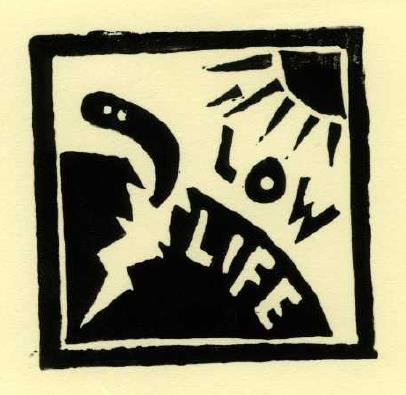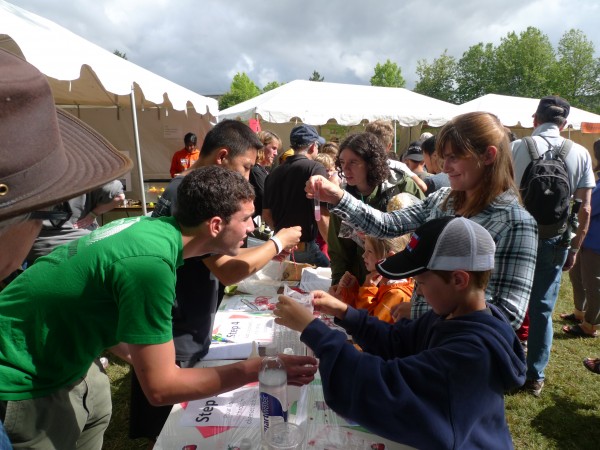5 November 2013
What Would Leonardo Do?
Posted by Olivia Ambrogio
By Rick Colwell

Passport stamp used to verify a visit to the Geomicrobiology exhibit during da Vinci Days. Art and photo by R. Colwell.
Want to communicate about science with kids in a compelling way? Guest blogger Rick Colwell and his geomicrobiology group at Oregon State University learned from experience that it helps to give young folks something fun and informative to do and to give them something to take away with them, too. Figuring that out took a couple of tries, Colwell recalls.
In 2009, our college celebrated its 50th anniversary with an open house linked to the Corvallis da Vinci Days (http://www.davincidays.org/), an annual weekend celebration of the arts and sciences. College research groups organized stations to explain to the public what we do and why they should care.
Our Geomicrobiology group had a table with rocks to describe where we found microbes in earth systems. That was fine (talking about life in rocks), but the real excitement was the “Low Life” stamp we made for kids to add to their science passports to show that they’d been to our station. We had kids arriving saying “Where’s the Low Life stamp?” and they didn’t even care about life in rocks. This made perfect sense: these kids wanted to do something and maybe even take a souvenir with them.The next summer with da Vinci Days around the corner we resolved to participate again with the festival but with something more interactive for kids. Sonia Trevino-Dopatka, one of the students working with us that summer as an REU fellow (Research Experience for Undergraduates), suggested DNA extraction from strawberries. That’s an activity akin to how our lab extracts DNA to study geologically important microbes.
It’s a simple and safe procedure, with many versions of it published on-line. Here’s one: http://www.gs.washington.edu/outreach/dhillon_dnaprocedure.pdf.
We set it up so that the kids could move to different stations along a table as they stepped through the extraction. At the end, they placed the extracted DNA into a cool little test tube to make a necklace. Some of our Saturday visitors were back on Sunday to do it again! We estimate that about 200 kids join us to extract strawberry DNA during each da Vinci Days festival.

Students Michael Graw and Andrew Qin (both on left) helping da Vinci Days visitors extract DNA from strawberries. Photo by R. Colwell.
Doing this activity has become a Geomicrobiology tradition (along with other college exhibits). Our graduate and undergraduate students are involved and Jessie Wishart, one of the graduate students in our lab, is responsible for organizing the weekend DNA extractions.
We have a couple of challenges. First, how can you draw a link between the DNA in strawberries and DNA in Earth microbes? We do this with a poster that describes the concept pictorially: DNA is the blueprint for life, all life has DNA (strawberries, people, microbes), life (mostly microbial) is underground too, etc. I think this works on some level but, really, the kids seem most excited by the cute little tubes, each with its floating puff of DNA.
The other challenge is those darn volcanologists at the neighboring table. Rascals. They have a simulated volcanic eruption, which frankly is a little over-the-top compared to DNA. When that mini-Krakatoa goes off even the most dedicated junior biologist turns her head!
Is it worth it? Here’s my answer: a few years ago, when we were first fumbling through the demos we had pen and paper handy to describe things for those inclined to detail. On Sunday afternoon, as the crowds dwindled we started to cleanup the mess. I found this on a piece of paper:

Sentiment left by an anonymous visitor to the da Vinci Days Geomicrobiology exhibit. Photo by R. Colwell.
You tell me.
— Rick Colwell is a professor of Ocean Ecology and Biogeochemistry at Oregon State University.










 The Plainspoken Scientist is the science communication blog of AGU’s Sharing Science program. With this blog, we wish to showcase creative and effective science communication via multiple mediums and modes.
The Plainspoken Scientist is the science communication blog of AGU’s Sharing Science program. With this blog, we wish to showcase creative and effective science communication via multiple mediums and modes.